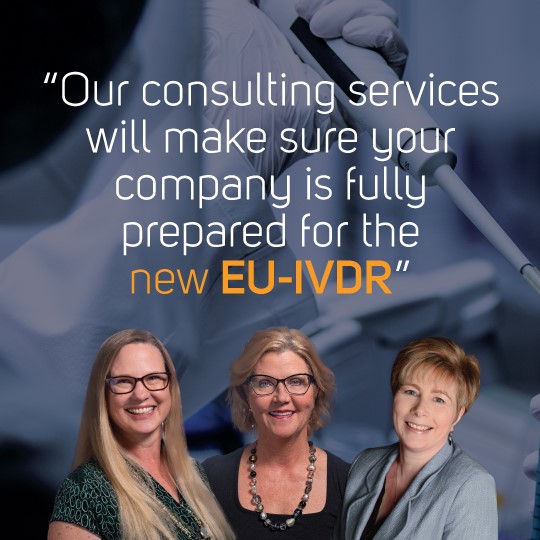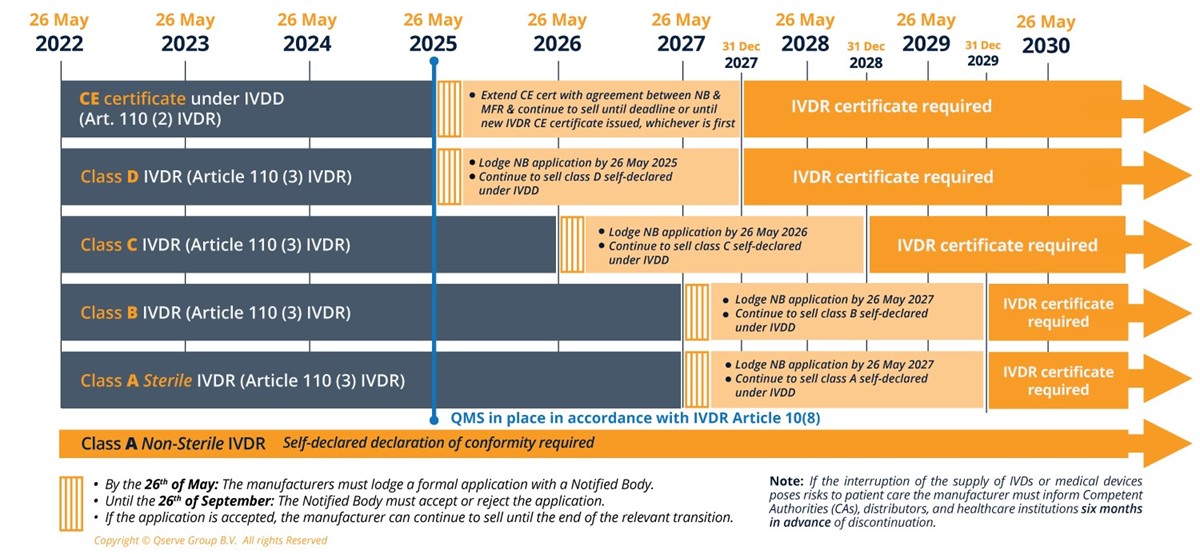Transitional arrangements
IVDR compliance timelines
Since the 26th of May 2022, all devices must meet the IVDR regulation, and manufacturers are looking for support to achieve IVDR compliance. There has been an extension to the transitional arrangements for some devices to enable additional time for conformity reviews, but the IVDR is now effective. When the commission made its proposal, they stated that there were conditions; "These conditions will ensure that only manufacturers that are actively taking the necessary steps to transition to the new rules and continue to place on the market devices meeting high safety standards will benefit from the additional time." It is therefore important to continue IVDR implementation to take advantage of this extension.

The diagram helps to explain what the proposal for the extension of transitional arrangements looks like.

This diagram includes details of the proposal 2024/0021 COD announced in January 2024 and is discussed in more detail in our webinar Understanding and effectively using the IVDR transition for successful CE marking on 28 May 2024; visit our website for this and other useful training and events.
The IVDR is constantly evolving. Download the EU-IVDR support leaflet with the timelines to keep the IVDR implementation moving.
Download EU-IVDR leaflet
To take advantage of the proposed transitions, manufacturers must:
- Continue to meet the IVDD.
- No significant changes can be made to the device or its intended use.
- Have a quality management system (QMS) in place to support the IVDR transition no later than 26 May 2025.
- Meet post-market requirements, effective for all devices, not just those that have completed the IVDR transition. Once an agreement is signed with the Notified Body, they will become responsible for surveillance.
- All clinical performance studies and post-market follow-up studies must meet Annex XIII and XIV requirements where applicable.
- Inform CA and health institutions 6 months prior to any permanent or temporary interruption to the supply of devices that may cause serious harm or a risk of serious harm to patients.
To continue to sell products during the transition, manufacturers must lodge an application with the notified body and continue to meet the above questions. If the next generation of a device will be implemented during the transition, the notified body should agree to this so that the original device can remain on the market while the new devices complete the notified body review.
Class A non-sterile devices do not have the benefit of an extension. The extension was provided to allow time to navigate the conformity assessment process with a Notified Body; since these devices are self-declared, there was no need for an extension. This includes extraction kits, accessories, and instruments.
The essential IVDR compliance elements required
From 26 May 2022, ALL devices must:
- Update the QMS to meet the IVDR.
- Create a transition plan and update it as new guidance evolves.
- Update design control to include GRPRs for new devices and significant changes and prepare an IVDR-compliant technical file for all transitioning devices.
- Include an assessment of significant change according to MDCG 2022-06 in the change control process.
- Implement IVDR post-market requirements, including PMS Plan, PMS Report, PMPF, and vigilance. SSP and PSUR are not required prior to applying the IVDR, but trend reporting is expected.
- Conduct any new clinical performance studies according to Annex XIII and XIV as appropriate and use ISO20916. Perform a gap assessment of the clinical data to be used for a transitioning device against these requirements.
- Identify a Person Responsible for Regulatory Compliance (PRRC) and formally appoint a PRRC before placing the first product on the market under the IVDR.
- Register Economic Operators in EUDAMED. EUDAMED is not fully functional but will be required 6 months after it becomes operational under the new proposals. Update supplier control and contracts as appropriate to ensure economic operators will be able to meet requirements.
Class A non-sterile devices, in addition to the above
- Should have a full technical file that meets all IVDR requirements. Detail should be appropriate for the risk of the device.
- Operate a QMS that meets the IVDR.
- Sign a declaration of conformity to the IVDR.
- Meet all post-market requirements.
Class A Sterile, B, C, and D devices
- Implement the appropriate harmonized sterilization standard depending on the method applied. For transitioning devices, read MDCG 2022-8.
- Additional relabelling of legacy devices is not required, but compliance with the IVDD must be maintained in the transition. There is no requirement to add UDI; see 2019-5 for the registration of legacy devices in EUDAMED.
- Get ready, have a written plan for the IVDR, and allow plenty of time for conformity assessments.
Companies should ensure that they are in contact with a Notified Body to arrange conformity assessment and ensure that they have an agreed contract in place for transitioning devices by the dates prescribed in 2024/0021. Pay attention to your selected Notified Bodies' guidance describing how they require a file to be presented. Manufacturers are expected to keep files up to date with the latest standards and guidance.
Ensure you factor sufficient time in for the conformity assessment. Notified body approval can take 18 months. Notified Body availability is fluid; the EU Commission surveys all Notified Bodies about how long it takes for conformity assessment, and the latest version is published on the Commission Notified Body page and updated regularly.
IVDR services
Classification
The IVD Directive 98/79/EC specified the involvement of a Notified Body for conformity assessment for only a few high-risk IVDs listed in Annex II list A, list B, and self-test devices. The list-based system quickly became outdated as technology and medicine advanced; therefore, the IVD Regulation introduced a risk-based classification, Class A to D, according to implementation and classification rules described in Annex VIII of the IVDR. This classification is based on the IMDRF classification but is not identical.
The outcome of these changes is that most IVDs now need a Notified Body's involvement for conformity assessment. In the past, at least 80% of IVDs were self-declared by the manufacturer, so this is a significant change. As a result, the majority of IVDs currently self-certified now require the services of a Notified Body to conduct the conformity assessment process to ensure the quality management system and technical documentation are met. This includes the General Safety and Performance Requirements (GSPR), which incorporate analytical and clinical performance to demonstrate that the intended purpose has been met.
Classification IVDR
Customized training sessions
Regulatory support is an investment, especially for small companies. In order to get the best return on your investment, we are happy to work with your staff to coach them through their initial IVDR or FDA submission. This enables regulatory knowledge to be grown and retained within the company. This can be offered through formal training or more informal coaching.
- IVDR for C-Suite (what executives need to know)
- Preparing technical files
- Risk management to meet the IVDR
- Clinical requirements (Scientific Validity Report, Analytical and Clinical Performance Reports)
- Clinical Performance Studies and ISO 20916
- Literature searches for Scientific Validity and State of the Art Reports
- Software how to meet IEC 62304 plus AI and the IVDR
- Companion diagnostic
- Compliance for Lab developed tests (LDT) and distance sales
- Post-market surveillance and post-market performance follow-up
- Getting ready for Notified Body audits
- Person Responsible for Regulatory Compliance (PRRC) and economic operators
Training sessions
How can we help you?
Implementation of any new regulation is always a rollercoaster ride, and we are here to support you! We also understand you are a global
business and that the IVDR may have implications for other submissions,
presenting both opportunities and threats. It's, therefore, important to work with a team that has practical experience in the industry and can help you find the more efficient route to compliance.
Our IVDR experts can help you decide where to start an initial conversation. This can be a wise investment, as mistakes in the strategy can be expensive in time and money.
Qserve has worked for companies of different sizes, from small to multinational. All companies and devices present different challenges; we understand that solutions are needed to meet all pockets and needs to become IVDR compliant. We offer a flexible and pragmatic approach to support your individual needs.
So don't hesitate to ask for an introductory call; it could be a good investment of time!
Contact us